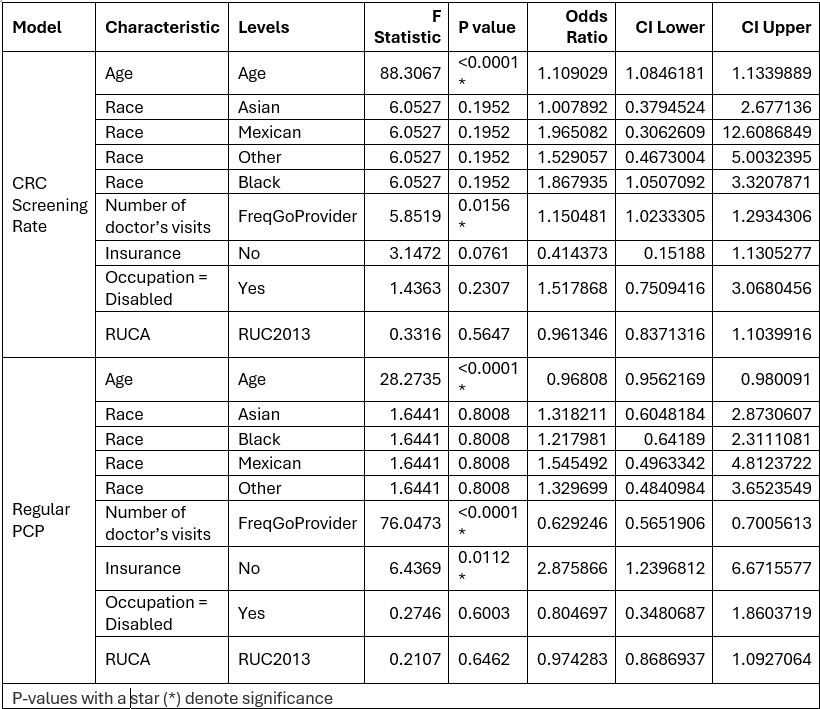Tuesday Poster Session
Category: Colorectal Cancer Prevention
P4746 - Impact of Disability and Frequency of Primary Care Physician (PCP) Visits on Colorectal Cancer (CRC) Screening Rates
Tuesday, October 28, 2025
10:30 AM - 4:00 PM PDT
Location: Exhibit Hall

Oladoyin Jolaoye, MD, DO
OSF Saint Francis Medical Center
Peoria, IL
Presenting Author(s)
Oladoyin Jolaoye, MD, DO1, Tyler Jensen, BS1, Sonu Dhillon, MD1, Ogonna Ngwu, MD2
1OSF Saint Francis Medical Center, Peoria, IL; 2Mercy Hospital, Cincinnati, OH
Introduction: A barrier encountered by individuals with disability in CRC screening is the frequency of visitation to a healthcare provider. We examined the impact on CRC screening rates among people with disability and their frequency of Primary Care Physician (PCP) visits.
Methods: We conducted a retrospective analysis using data from the National Trends Survey (HINTS 5), cycle 4 of 253,815,197 households, comprising 19,241,439 individuals who have some form of disability. We used descriptive statistics to summarize survey responses and reported weighted values. We performed the analysis in R (R Core Team, 2024), calculated P-values, and assumed a two-sided, 5% level of significance. We employed weighted logistic regression models to account for survey weights and used the quasibinomial family to allow for non-integer counts. Logistic regression models were fitted to assess these relationships, significant predictors were identified using Type III ANOVA tests, and model fit and significance were assessed using likelihood ratio tests and variance inflation factors.
Results: Our model shows that the number of PCP visits increases the odds of CRC screening (OR = 1.15, CI: 1.02-1.29). There is an association between CRC screening and the number of PCP visits (P < 0.05) shown in Table 1, but there is no association between CRC screening and disability (p > 0.05) in the model. Disabled individuals visit PCPs more frequently compared to those who are employed, homemakers, and students, as indicated by the positive test statistics and significant p-values (p < 0.05) in Table 2. The Anova results indicate that age and frequency of going to a provider are significant predictors, with p-values less than 0.05. This suggests that these factors have a strong influence on CRC screening rates.
Discussion: Inaccessible facilities, inability of a disabled individual to find transportation to a healthcare appointment are barriers to screening. Different types of disabilities can also hinder CRC screening rates; individuals with chronic back injuries are less likely to undergo CRC screening. Targeted interventions should be made among individuals with disabilities to increase PCP visits and increase CRC screening rates. Screening kits can be mailed to individuals with disabilities who can’t be transported for screening, improving transportation needs, and ensuring that medical facilities have easy access for individuals with disabilities are important to increase PCP visits and CRC screening rates.

Figure: Table 1: Statistical Analysis of the study population

Figure: Table 2: Chi-Square Test Results with P-Value Adjustments
Disclosures:
Oladoyin Jolaoye indicated no relevant financial relationships.
Tyler Jensen indicated no relevant financial relationships.
Sonu Dhillon indicated no relevant financial relationships.
Ogonna Ngwu indicated no relevant financial relationships.
Oladoyin Jolaoye, MD, DO1, Tyler Jensen, BS1, Sonu Dhillon, MD1, Ogonna Ngwu, MD2. P4746 - Impact of Disability and Frequency of Primary Care Physician (PCP) Visits on Colorectal Cancer (CRC) Screening Rates, ACG 2025 Annual Scientific Meeting Abstracts. Phoenix, AZ: American College of Gastroenterology.
1OSF Saint Francis Medical Center, Peoria, IL; 2Mercy Hospital, Cincinnati, OH
Introduction: A barrier encountered by individuals with disability in CRC screening is the frequency of visitation to a healthcare provider. We examined the impact on CRC screening rates among people with disability and their frequency of Primary Care Physician (PCP) visits.
Methods: We conducted a retrospective analysis using data from the National Trends Survey (HINTS 5), cycle 4 of 253,815,197 households, comprising 19,241,439 individuals who have some form of disability. We used descriptive statistics to summarize survey responses and reported weighted values. We performed the analysis in R (R Core Team, 2024), calculated P-values, and assumed a two-sided, 5% level of significance. We employed weighted logistic regression models to account for survey weights and used the quasibinomial family to allow for non-integer counts. Logistic regression models were fitted to assess these relationships, significant predictors were identified using Type III ANOVA tests, and model fit and significance were assessed using likelihood ratio tests and variance inflation factors.
Results: Our model shows that the number of PCP visits increases the odds of CRC screening (OR = 1.15, CI: 1.02-1.29). There is an association between CRC screening and the number of PCP visits (P < 0.05) shown in Table 1, but there is no association between CRC screening and disability (p > 0.05) in the model. Disabled individuals visit PCPs more frequently compared to those who are employed, homemakers, and students, as indicated by the positive test statistics and significant p-values (p < 0.05) in Table 2. The Anova results indicate that age and frequency of going to a provider are significant predictors, with p-values less than 0.05. This suggests that these factors have a strong influence on CRC screening rates.
Discussion: Inaccessible facilities, inability of a disabled individual to find transportation to a healthcare appointment are barriers to screening. Different types of disabilities can also hinder CRC screening rates; individuals with chronic back injuries are less likely to undergo CRC screening. Targeted interventions should be made among individuals with disabilities to increase PCP visits and increase CRC screening rates. Screening kits can be mailed to individuals with disabilities who can’t be transported for screening, improving transportation needs, and ensuring that medical facilities have easy access for individuals with disabilities are important to increase PCP visits and CRC screening rates.

Figure: Table 1: Statistical Analysis of the study population

Figure: Table 2: Chi-Square Test Results with P-Value Adjustments
Disclosures:
Oladoyin Jolaoye indicated no relevant financial relationships.
Tyler Jensen indicated no relevant financial relationships.
Sonu Dhillon indicated no relevant financial relationships.
Ogonna Ngwu indicated no relevant financial relationships.
Oladoyin Jolaoye, MD, DO1, Tyler Jensen, BS1, Sonu Dhillon, MD1, Ogonna Ngwu, MD2. P4746 - Impact of Disability and Frequency of Primary Care Physician (PCP) Visits on Colorectal Cancer (CRC) Screening Rates, ACG 2025 Annual Scientific Meeting Abstracts. Phoenix, AZ: American College of Gastroenterology.
